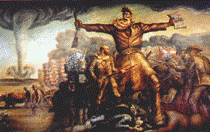History, Department of

James A. Rawley Graduate Conference in the Humanities
Date of this Version
April 2008
Document Type
Article
Abstract
Between the second, third and fourth centuries the Christian Church produced biographies chronicling the pious undertakings of monks. These hagiographies borrowed from preexisting Greek biographies to distinguish the Christian monk from the pagan holy man. Patricia Cox Miller’s Biography in Late Antiquity: The Quest for the Holy Man demonstrates how hagiographers adaptation of Greek biographies allowed them to create idealized portraits of Christian holy men and distinguish them from their pagan counterparts. This paper applies Cox Miller’s method to examine portions of The Saints Lives, The Lausiac Histories and The History of the Monks of Egypt in order to demonstrate the shared conception of death within these works. This paper argues that hagiographers desire to present idealized holy men created a distinct and consistent portrayal of death in their writing. Hagiographers’ articulation of the monk’s power over death established a unique community within Late Antiquity based on mastery over mortality through monastic life.
The monk’s mastery over death is a large part of his authority in Late Antiquity. Hagiographers constructed their narratives to not only to edify but to persuade their audience. These narratives transformed individual monks into an imagined community. The monk’s triumph at the hour of death mirrors that of the Christian Church over paganism in the religious marketplace of Late Antiquity.


Comments
Paper presented at the 3rd Annual James A. Rawley Conference in the Humanities — Imagining Communities: People, Places, Meanings. Lincoln, Nebraska, April 12, 2008. Sponsored by the University of Nebraska–Lincoln History Graduate Students’ Association. Copyright © 2008 Paul Ferderer.